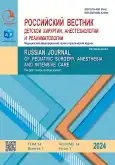先天性胫骨前脱位:一种非侵入性治疗方法
- 作者: Kruglov I.Y.1, Rumyantsev N.Y.1, Omarov G.G.2, Smirnov S.S.1,3, Kagantsov I.M.1,2
-
隶属关系:
- V.A. Almazov National Medical Research Center
- North-Western State Medical University named after I.I. Mechnikov
- Vreden National Medical Center for Traumatology and Orthopedics
- 期: 卷 14, 编号 1 (2024)
- 页面: 33-44
- 栏目: Original Study Articles
- URL: https://journals.rcsi.science/2219-4061/article/view/257472
- DOI: https://doi.org/10.17816/psaic1775
- ID: 257472
如何引用文章
全文:
详细
论证。在出生后立即应用新的治疗方法的背景下,先天性胫骨前脱位的研究颇受关注。这一举措的主要目的是确保关节从生命的最早阶段就能够正常形成和功用,从而最大限度地减少脱位的后果。 这不仅是一项技术成就,也是确保先天性胫骨前脱位患儿的健康和发育获得最佳条件的 战略方法。
目的。本研究的目的是评估用一种新的专利方法治疗先天性胫骨前脱位这种罕见病症的功能效果和长期前景。
材料与方法。共对120例先天性胫骨前脱位患者(194个膝关节)进行了检查。受检患者分为主要组和对照组,主要组55例(90个膝关节),对照组65例(104个膝关节)。主治疗组的儿童使用了由作者开发的Ergopower ER 7028型振动按摩器进行治疗。对照组采用传统的胫骨前脱位矫形方法,使用冯·罗森夹板和圆形石膏模型。主治疗组患者开始治疗时的年龄为28岁[Q1 28; Q3 30],对照组为30岁[Q1 28; Q3 34.5]。
结果。对主要治疗组和对照组儿童患者的治疗结果进行的比较分析表明,与传统技术相比,所开发的使用仪器振动按摩和细致操作矫正先天性胫骨前脱位的方法可在95%的病例中进行最准确的矫形矫正,确保恢复膝关节的轴向轮廓及其稳定性,并为成年后下肢形成和谐的生长发育类型创造条件。主要组患者在采用改良技术保守治疗先天性小腿前脱位后,经过5年的观察,观察到主组患者的膝关节功能评估优良率(66.7%)和疼痛综合征缓解率(98.2%)指标普遍优良,临床检查和专业问卷调查的数据均予以证实。
结论。通过振动大腿肌肉血管对先天性胫骨前脱位进行保守矫形的创新方法,使得在进行保守治疗时可以采用不同的方法,从而提高了总体治疗效果和长期疗效。
作者简介
Igor Yu. Kruglov
V.A. Almazov National Medical Research Center
编辑信件的主要联系方式.
Email: dr.gkruglov@gmail.com
ORCID iD: 0000-0003-1234-1390
SPIN 代码: 7777-1047
俄罗斯联邦, Saint Petersburg
Nicolai Yu. Rumyantsev
V.A. Almazov National Medical Research Center
Email: dr.rumyantsev@gmail.com
ORCID iD: 0000-0002-4956-6211
俄罗斯联邦, Saint Petersburg
Gamzat G. Omarov
North-Western State Medical University named after I.I. Mechnikov
Email: ortobaby@yandex.ru
ORCID iD: 0000-0002-9252-8130
SPIN 代码: 9565-8513
MD, Cand. Sci. (Medicine)
俄罗斯联邦, Saint PetersburgSergey S. Smirnov
V.A. Almazov National Medical Research Center; Vreden National Medical Center for Traumatology and Orthopedics
Email: smirnovss_md@mail.ru
ORCID iD: 0000-0002-3210-9962
SPIN 代码: 4352-9475
俄罗斯联邦, Saint Petersburg; Saint Petersburg
Ilya M. Kagantsov
V.A. Almazov National Medical Research Center; North-Western State Medical University named after I.I. Mechnikov
Email: ilkagan@rambler.ru
ORCID iD: 0000-0002-3957-1615
SPIN 代码: 7936-8722
MD, Dr. Sci. (Medicine)
俄罗斯联邦, Saint Petersburg; Saint Petersburg参考
- Mehrafshan M, Wicart P, Ramanoudjame M, et al. Congenital dislocation of the knee at birth — Part I: Clinical signs and classification. Orthop Traumatol Surg Res. 2016;102(5):631–633. doi: 10.1016/j.otsr.2016.04.008
- Klein C, Bulaid Y, Deroussen F, et al. Congenital dislocation of the knee in a three-year-old-child with Larsen syndrome: Treatment with a hexapod-type external fixator. Knee. 2018;25(5):966–971. doi: 10.1016/j.knee.2018.07.006
- Kruglov IY, Agranovich OE, Rumyantsev NY, et al. Congenital dislocation of the knee: a morphological study. Pediatric Traumatology, Orthopaedics and Reconstructive Surgery. 2020;8(4):427–435. EDN: CBRFDQ doi: 10.17816/PTORS25809
- Kruglov IY, Rumyantsev NY, Rumyantseva NN, et al. Some morphological prerequisites for the use of vibration massage in the treatment of congenital dislocation of the knee. Medline.ru. 2023;24(2):1160–1171. EDN: CIYMCY
- Patent RU 2789202 C1 /31.01.2023. Kruglov IY, Rumyantsev NY, Kagantsov IM, et al. Method of treatment of congenital anterior dislocation of the tibia of idiopathic character of moderate and severe degree in newborns and infants. (In Russ.)
- Kruglov IY, Rumyantsev NY, Agranovich OE, et al. Current views on the management of congenital dislocation of the knee based on current data on the outcomes of orthopedic treatment in these patients. N.N. Priorov Journal of Traumatology and Orthopedics. 2021;28(3):93–100. EDN: UUIQCE doi: 10.17816/vto71231
- Ferris B, Aichroth P. The treatment of congenital knee dislocation. Clin Orthop Relat Res. 1987;216:135–140. doi: 10.1097/00003086-198703000-00021
- Bortulev PI. Optimisation of surgical treatment of children with dysplastic hip subluxation [dissertation]. Saint Petersburg, 2020. 112 p. (In Russ.)
- Abdelaziz TH, Samir S. Congenital dislocation of the knee: a protocol for management based on degree of knee flexion. J Child’s Orthop. 2011;5(2):143–149. doi: 10.1007/s11832-011-0333-7
- Kruglov IY, Rumyantsev NY, Baindurashvili AG, et al. Comparison of the clinical and radiological pictures in patients with congenital knee dislocation during treatment. Pediatric Traumatology, Orthopaedics and Reconstructive Surgery. 2023;11(1):39–48. EDN: KXFJCD doi: 10.17816/PTORS111181
- Hung NN, Tan D, Do Ngoc Hien N. Patellar dislocation due to iatrogenic quadriceps fibrosis: results of operative treatment in 54 cases. J Child Orthop. 2014;8(1):49–59. doi: 10.1007/s11832-014-0564-5
- Kaissi AA, Ganger R, Klaushofer K, Grill F. The management of knee dislocation in a child with Larsen syndrome. Clinics (Sao Paulo). 2011;66(7):1295–1299. doi: 10.1590/s1807-59322011000700030
- Flowers D, Olmedo M. Non-surgical management of a tibiofemoral knee dislocation in a patient with sarcoidosis. BMJ Case Rep. 2019;12(11):e229605. doi: 10.1136/bcr-2019-229605
- Morales-Roselló J, Loscalzo G, Hueso-Villanueva M, et al. Congenital knee dislocation, case report and review of the literature. J Matern Fetal Neonatal Med. 2022;35(4):809–811. doi: 10.1080/14767058.2020.1731464
- Shah NR, Limpaphayom N, Dobbs MB. A minimally invasive treatment protocol for the congenital dislocation of the knee. J Pediatr Orthop. 2009;29(7):720–725. doi: 10.1097/BPO.0b013e3181b7694d
- Youssef AO. Limited open quadriceps release for treatment of congenital dislocation of the knee. J Pediatr Orthop. 2017;37(3):192–198. doi: 10.1097/BPO.0000000000000612
- Patwardhan S, Shah K, Shyam A, Sancheti P. Assessment of clinical outcome of percutaneous needle quadriceps tenotomy in the treatment of congenital knee dislocation. Int Orthop. 2015;39(8):1587–1592. doi: 10.1007/s00264-015-2806-7
- Carlson HD, O’Connor J. Congenital dislocation of the knee. Am J Roentgenol. 1976;127(3):465–468. doi: 10.2214/ajr.127.3.465
- Charif P, Reichelderfer TE. Genu recurvatum congenitum in the newborn. Clin Pediatr. 1965;4(10):587–594. doi: 10.1177/000992286500401006
- Nogi J, Mac Ewen D. Congenital dislocation of the knee. J Pediatr Orthop. 1982;2(5):509–513. doi: 10.1097/01241398-198212000-00009
- Rumyantsev NY, Kruglov IY, Omarov GG, et al. Congenital dislocation of the knee: prenatal diagnostics and treatment at an early age. Pediatric Traumatology, Orthopaedics and Reconstructive Surgery. 2017;5(2):26–35. EDN: YSTYIL doi: 10/17816/PTORS5226-35
- Rampal V, Mehrafshan M, Ramanoudjame M, et al. Congenital dislocation of the knee at birth — Part 2: Impact of a new classification on treatment strategies, results and prognostic factors. Orthop Traumatol Surg Res. 2016;102(5):635–638. doi: 10.1016/j.otsr.2016.04.009
补充文件












